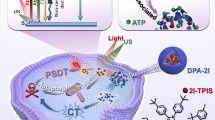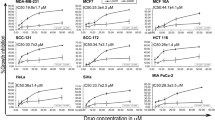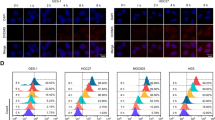Summary
Development of sonosensitizers for sonodynamic therapy (SDT) which selectively target abnormal cells can limit undesired side effects in chemotherapeutic applications. Hypocrellin-B (HB) derivatives are low molecular weight compounds which belong to the perylenequinone family of photosensitizing and sonosensitizing compounds. In this study, we investigate the cytotoxic mechanisms of a novel HB-derived photo- and sonosensitizer, SL017. Human fibroblast WI-38 cells were treated with SL017 (0 μM, 0.1 μM or 10 μM) and subjected to photodynamic therapy (PDT) or SDT. Studies demonstrate that maximal uptake of SL017 occurs within 30 min, with a mitochondrial subcellular localization. Activation of SL017 by either visible light or ultrasound resulted in significant increases in reactive oxygen species (ROS) production as measured by CM-H2-DCFDA (5-(and-6)-chloromethyl-2′7′-dichlorodihydrofluorescein diacetate acetyl ester). Co-administration of the antioxidant, ascorbic acid, attenuated ROS production. Low concentrations of SL017 (100 nM) induced a rapid (<90 s) loss of mitochondrial membrane potential (ΔΨm). Epoxyeicosatrienoic acids (EETs), cytochrome P450-derived metabolites of arachidonic acid (AA) involved in maintaining homeostasis and protection against cell injury, were able to attenuate loss of ΔΨm, however ascorbic acid was not. SL017 treatment resulted in increased mitochondrial fragmentation which followed loss of ΔΨm. Our studies demonstrate that SL017 targets mitochondria, triggering collapse of mitochondrial membrane potential, generates ROS and subsequently results in mitochondrial fragmentation.





Similar content being viewed by others
References
Rockson SG, Lorenz DP, Cheong WF, Woodburn KW (2000) Photoangioplasty: an emerging clinical cardiovascular role for photodynamic therapy. Circulation 102(5):591–596
Tachibana K, Feril LB Jr, Ikeda-Dantsuji Y (2008) Sonodynamic therapy. Ultrasonics 48(4):253–259. doi:10.1016/j.ultras.2008.02.003
Tang W, Liu Q, Wang X, Wang P, Zhang J, Cao B (2009) Potential mechanism in sonodynamic therapy and focused ultrasound induced apoptosis in sarcoma 180 cells in vitro. Ultrasonics 49(8):786–793. doi:10.1016/j.ultras.2009.06.002
Hiraoka W, Honda H, Feril LB Jr, Kudo N, Kondo T (2006) Comparison between sonodynamic effect and photodynamic effect with photosensitizers on free radical formation and cell killing. Ultrason Sonochem 13(6):535–542. doi:10.1016/j.ultsonch.2005.10.001
Rosenthal I, Sostaric JZ, Riesz P (2004) Sonodynamic therapy—a review of the synergistic effects of drugs and ultrasound. Ultrason Sonochem 11(6):349–363. doi:10.1016/j.ultsonch.2004.03.004
Ali SM, Chee SK, Yuen GY, Olivo M (2001) Hypericin and hypocrellin induced apoptosis in human mucosal carcinoma cells. J Photochem Photobiol B 65(1):59–73
Miller GG, Brown K, Ballangrud AM, Barajas O, Xiao Z, Tulip J, Lown JW, Leithoff JM, Allalunis-Turner MJ, Mehta RD, Moore RB (1997) Preclinical assessment of hypocrellin b and hypocrellin b derivatives as sensitizers for photodynamic therapy of cancer: progress update. Photochem Photobiol 65(4):714–722
Roman RJ (2002) P-450 metabolites of arachidonic acid in the control of cardiovascular function. Physiol Rev 82(1):131–185. doi:10.1152/physrev.00021.2001
Seubert JM, Sinal CJ, Graves J, DeGraff LM, Bradbury JA, Lee CR, Goralski K, Carey MA, Luria A, Newman JW, Hammock BD, Falck JR, Roberts H, Rockman HA, Murphy E, Zeldin DC (2006) Role of soluble epoxide hydrolase in postischemic recovery of heart contractile function. Circ Res 99(4):442–450. doi:10.1161/01.RES.0000237390.92932.37
Dhanasekaran A, Gruenloh SK, Buonaccorsi JN, Zhang R, Gross GJ, Falck JR, Patel PK, Jacobs ER, Medhora M (2008) Multiple antiapoptotic targets of the pi3k/akt survival pathway are activated by epoxyeicosatrienoic acids to protect cardiomyocytes from hypoxia/anoxia. Am J Physiol Heart Circ Physiol 294(2):H724–H735. doi:10.1152/ajpheart.00979.2007
Gauthier KM, Yang W, Gross GJ, Campbell WB (2007) Roles of epoxyeicosatrienoic acids in vascular regulation and cardiac preconditioning. J Cardiovasc Pharmacol 50(6):601–608. doi:10.1097/FJC.0b013e318159cbe3
Gross GJ, Hsu A, Falck JR, Nithipatikom K (2007) Mechanisms by which epoxyeicosatrienoic acids (eets) elicit cardioprotection in rat hearts. J Mol Cell Cardiol 42(3):687–691. doi:10.1016/j.yjmcc.2006.11.020
Zhang Y, El-Sikhry H, Chaudhary KR, Batchu SN, Shayeganpour A, Jukar TO, Bradbury JA, Graves JP, DeGraff LM, Myers P, Rouse DC, Foley J, Nyska A, Zeldin DC, Seubert JM (2009) Overexpression of cyp2j2 provides protection against doxorubicin-induced cardiotoxicity. Am J Physiol Heart Circ Physiol 297(1):H37–H46. doi:10.1152/ajpheart.00983.2008
Katragadda D, Batchu SN, Cho WJ, Chaudhary KR, Falck JR, Seubert JM (2009) Epoxyeicosatrienoic acids limit damage to mitochondrial function following stress in cardiac cells. J Mol Cell Cardiol 46(6):867–875. doi:10.1016/j.yjmcc.2009.02.028
Jiang JG, Chen CL, Card JW, Yang S, Chen JX, Fu XN, Ning YG, Xiao X, Zeldin DC, Wang DW (2005) Cytochrome p450 2j2 promotes the neoplastic phenotype of carcinoma cells and is up-regulated in human tumors. Cancer Res 65(11):4707–4715. doi:10.1158/0008-5472.CAN-04-4173
Jiang JG, Ning YG, Chen C, Ma D, Liu ZJ, Yang S, Zhou J, Xiao X, Zhang XA, Edin ML, Card JW, Wang J, Zeldin DC, Wang DW (2007) Cytochrome p450 epoxygenase promotes human cancer metastasis. Cancer Res 67(14):6665–6674. doi:10.1158/0008-5472.CAN-06-3643
Jakus J, Farkas O (2005) Photosensitizers and antioxidants: a way to new drugs? Photochem Photobiol Sci 4(9):694–698. doi:10.1039/b417254j
Estey EP, Brown K, Diwu ZJ, Lin JX, Lown JW, Miller GG, Moore RB, Tulip J, McPhee MS (1996) Hypocrellins as photosensitizers for photodynamic therapy: a screening evaluation and pharmacokinetic study. Cancer Chemother Pharmacol 37(4):343–350
Yumita N, Umemura S, Magario N, Umemura K, Nishigaki R (1996) Membrane lipid peroxidation as a mechanism of sonodynamically induced erythrocyte lysis. Int J Radiat Biol 69:397–404
Yumita N, Nishigaki R, Umemura K, Morse PD, Swartz HM, Cain CA, Umemura S (1994) Sonochemical activation of hematoporphyrin: an esr study. Radiat Res 138:171–176
Yumita N, Nishigaki R, Umemura K, Umemura S (1989) Hematoporphyrin as a sensitizer of cell-damaging effect of ultrasound. Jpn J Cancer Res 80:219–222
El Maalouf J, Bera JC, Alberti L, Cathignol D, Mestas JL (2009) In vitro sonodynamic cytotoxicity in regulated cavitation conditions. Ultrasonics 49(2):238–243. doi:10.1016/j.ultras.2008.09.001
Chan DC (2006) Mitochondria: dynamic organelles in disease, aging, and development. Cell 125(7):1241–1252. doi:10.1016/j.cell.2006.06.010
Furt F, Moreau P (2009) Importance of lipid metabolism for intracellular and mitochondrial membrane fusion/fission processes. Int J Biochem Cell Biol 41(10):1828–1836. doi:10.1016/j.biocel.2009.02.005
Maack C, O’Rourke B (2007) Excitation-contraction coupling and mitochondrial energetics. Basic Res Cardiol 102(5):369–392. doi:10.1007/s00395-007-0666-z
Stanley WC, Morgan EE, Huang H, McElfresh TA, Sterk JP, Okere IC, Chandler MP, Cheng J, Dyck JR, Lopaschuk GD (2005) Malonyl-coa decarboxylase inhibition suppresses fatty acid oxidation and reduces lactate production during demand-induced ischemia. Am J Physiol Heart Circ Physiol 289(6):H2304–H2309. doi:10.1152/ajpheart.00599.2005
Ussher JR, Lopaschuk GD (2008) The malonyl coa axis as a potential target for treating ischaemic heart disease. Cardiovasc Res 79(2):259–268. doi:10.1093/cvr/cvn130
Wang W, Fang H, Groom L, Cheng A, Zhang W, Liu J, Wang X, Li K, Han P, Zheng M, Yin J, Wang W, Mattson MP, Kao JPY, Lakatta EG, Sheu S-s, Ouyang K, Chen J, Dirksen RT, Cheng H (2008) Superoxide flashes in single mitochondria. Cell 279–290
Hanley PJ, Daut J (2005) K(atp) channels and preconditioning: a re-examination of the role of mitochondrial k(atp) channels and an overview of alternative mechanisms. J Mol Cell Cardiol 39(1):17–50. doi:10.1016/j.yjmcc.2005.04.002
Hausenloy DJ, Yellon DM (2004) New directions for protecting the heart against ischaemia-reperfusion injury: targeting the reperfusion injury salvage kinase (risk)-pathway. Cardiovasc Res 61(3):448–460. doi:10.1016/j.cardiores.2003.09.024
Hom J, S-s S (2009) Morphological dynamics of mitochondria—a special emphasis on cardiac muscle cells. J Mol Cell Cardiol 46:811–820
Benard G, Bellance N, James D, Parrone P, Fernandez H, Letellier T, Rossignol R (2007) Mitochondrial bioenergetics and structural network organization. J Cell Sci 120(Pt 5):838–848. doi:10.1242/jcs.03381
Davies VJ, Hollins AJ, Piechota MJ, Yip W, Davies JR, White KE, Nicols PP, Boulton ME, Votruba M (2007) Opa1 deficiency in a mouse model of autosomal dominant optic atrophy impairs mitochondrial morphology, optic nerve structure and visual function. Hum Mol Genet 16:1307–1318
Spector AA, Norris AW (2007) Action of epoxyeicosatrienoic acids on cellular function. Am J Physiol Cell Physiol 292(3):C996–C1012. doi:10.1152/ajpcell.00402.2006
Acknowledgements
JMS is the recipient of a New Investigator Award from the Heart and Stroke Foundation of Canada and a Health Scholar Award from the Alberta Heritage Foundation for Medical Research. This work was supported by Quest PharmaTech Inc. and in part by Canadian Institutes of Health Research Grant (JMS MOP79465).
Disclosure
RM Madiyalakan is the CEO of Quest PharmaTech Inc. GG Miller is a consultant to Quest PharmaTech Inc.
Author information
Authors and Affiliations
Corresponding author
Rights and permissions
About this article
Cite this article
El-Sikhry, H.E., Miller, G.G., Madiyalakan, M.R. et al. Sonodynamic and photodynamic mechanisms of action of the novel hypocrellin sonosensitizer, SL017: mitochondrial cell death is attenuated by 11, 12-epoxyeicosatrienoic acid. Invest New Drugs 29, 1328–1336 (2011). https://doi.org/10.1007/s10637-010-9495-2
Received:
Accepted:
Published:
Issue Date:
DOI: https://doi.org/10.1007/s10637-010-9495-2




